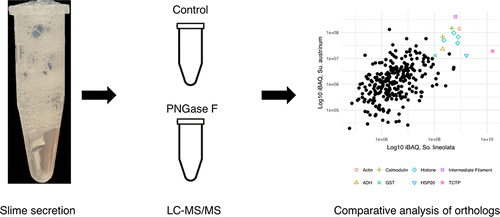Comparative Proteomic Analysis of Slime from the Striped Pyjama Squid, Sepioloidea lineolata, and the Southern Bottletail Squid, Sepiadarium austrinum (Cephalopoda: Sepiadariidae)

Sepioloidea lineolata, the striped pyjama squid (family Sepiadariidae), is a small species of benthic bobtail squid distributed along the Southern Indo-Pacific coast of Australia. Like other sepiadariid squids, it is known to secrete large volumes of viscous slime when stressed. In order to identify key proteins involved in the function of sepiadariid slimes, we compared the slime proteome of Sepioloidea lineolata with that of a closely related species, Sepiadarium austrinum. Of the 550 protein groups identified in Sepioloidea lineolata slime, 321 had orthologs in Sepiadarium austrinum, and the abundance of these (iBAQ) was highly correlated between species. Both slimes were dominated by a small number of abundant proteins, and several of these were short secreted proteins with no homologues outside the class Cephalopoda. No mucins were identified within either species’ slime, suggesting that it is structurally distinct from mucin polymer-based gels found in many vertebrate and echinoderm secretions. The extent of N-glycosylation in the slime of Sepioloidea lineolata was also studied via glycan cleavage with Peptide: N-glycosidase F (PNGase-F). Although very few (four) proteins showed strong evidence of N-glycosylation, we found that treatment with PNGase-F led to a slight increase in peptide identification rates compared with controls.